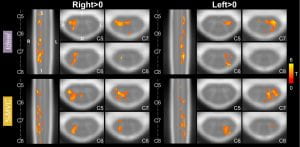 Hand-grasping is an important and clinically significant daily function, but more work is needed to understand the associated spinal cord neural activity. In this study, participants performed a hand-grasping task with both hands and spinal cord fMRI motor activation was modeled with two methods: (1) a typical idealized block design (Ideal) and (2) based on recorded grasp force normalized to individual maximum voluntary contraction (%MVC). Robust detection of hand-grasping activity was shown in the spinal cord, highly lateralized ipsilateral to the side of the task. In addition, the impact of sample size, number of fMRI runs, and spatial smoothing on activation estimates was explored. Overall, we emphasize the importance of a task that is well-controlled within and across participants. Using individually calibrated tasks in people with motor impairments will be especially beneficial to compare across groups.If you want to learn more, please check out the paper here!
Hand-grasping is an important and clinically significant daily function, but more work is needed to understand the associated spinal cord neural activity. In this study, participants performed a hand-grasping task with both hands and spinal cord fMRI motor activation was modeled with two methods: (1) a typical idealized block design (Ideal) and (2) based on recorded grasp force normalized to individual maximum voluntary contraction (%MVC). Robust detection of hand-grasping activity was shown in the spinal cord, highly lateralized ipsilateral to the side of the task. In addition, the impact of sample size, number of fMRI runs, and spatial smoothing on activation estimates was explored. Overall, we emphasize the importance of a task that is well-controlled within and across participants. Using individually calibrated tasks in people with motor impairments will be especially beneficial to compare across groups.If you want to learn more, please check out the paper here!